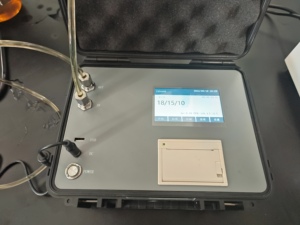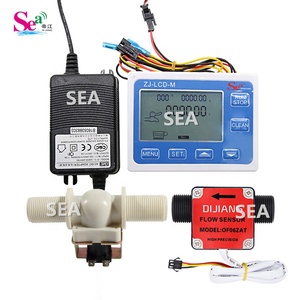
All categories
Featured selections
Trade Assurance
Buyer Central
Help Center
Get the app
Become a supplier

(1331 products available)



















































Instrument particle counters, especially those formulated for oil and other fluids, come in various arenas. In this section, we will consider the most commonly used types.
However, the choice of the kind tends to rely on the application and the industry used.
According to the definition, liquid particle counters are instruments that estimate the concentration, size, and distribution of pollutants in liquid samples. These devices are widely used for testing filtration systems in industries where precision is crucial, such as healthcare and food processing. The handheld and online liquid particle counters provide real-time data about the particle counts in the oil, ensuring optimal filtration and maintaining equipment health.
Optical counters, also known as imaging or laser diffraction particle counters, are widely used to measure suspended solids in oil and other liquids. These instruments work by passing a light beam through the fluid sample. Then, as the light scatters, the size of the particles is determined by measuring the scattered pattern of the light. An example of an industry that applies this counter is the oil-and-gas industry, where it is used to determine the size and concentration of droplets, emulsions, or dissolved substances in produced oil or water.
Aperture (or pore-size) particle counters work by measuring the change in electric current or resistance as the fluid sample passes through a calibrated aperture or pore. Larger particles will cause a noticeable blockage or change the electric current passing through the aperture compared to smaller ones. These instruments are often used in membrane or filter testing, where knowing the particle size distribution is essential in determining the efficiency of the filters in the industry.
As the name implies, the comparative particle counters assess the particle concentration based on a benchmark measurement. This is done by comparing the fluid sample under study with a fluid reference sample. The method is less precise but is often used where quick, such as the water and wastewater treatment and food processing industries, and checks are necessary.
Maintaining oil cleanliness is fundamental in various industries, including manufacturing, aerospace, marine, and food processing. The effects of particulate matter in oil can be wide, causing equipment damage, downtime, and expensive repairs. To mitigate this risk, businesses often use particle counters for oil in their operational checks, and here are some common industry applications.
The aerospace industry needs ultra-clean oils for both operational and safety reasons. The use of high particle counters is necessary to prevent any form of contamination from affecting the connective hardware performance or endangering the passengers. Thus, counters are widely utilized to assess the oil and hydraulic fluid volatility and ensure the industry standards are maintained and adhered to.
Likewise, in the marine industry, the demand for ideal oil cleanliness is high. It is because vessels usually face extreme conditions, and counter oil particle numbers are needed to protect vital systems from wear and tear caused by particles. The vessel's lube oil systems, fuel, and hydros also employ counters to reduce the risk of pump and engine failure and improve overall maintenance.
In the manufacturing sector, contaminants found in oils and lubricants used in machinery pose severe threats to mechanical parts. Then, when left unattended, these contaminants can lead to increased friction, wear and tear, and even a decrease in the product quality. To curb all these issues, particle counters are employed to ascertain the level of cleanliness to required standards and avert any potential risks.
As for the oil and gas production industries, they encounter a unique set of challenges related to particle contamination. Be it contaminants in extracted fluids or sediments in produced water, and everything in between; they are all potential threats to equipment integrity and environmental safety. That is why counters are indispensable in this industry, as they measure particle sizes in oil, water, and gas to prevent these impacts and adhere to safety standards.
Food processing relies on counters to ensure the oils used in frying cooking and lubrication are free of contaminants. This is because particles in oil can contaminate food products and, hence, counter are needed as they help maintain the quality of the product while ensuring consumer safety.
Various factors impact the design and functionality of a particle counter for oil, from the sensitivity, the size range it can detect, and the measurement system employed to the operating principle. Below, the features are further explained.
One of the main specifications to consider when selecting the correct counter is the size range of the measurable particles. It is because not all counters can detect the same size of particles, which can be a costly affair if the counter size range is not compatible with the oil used in the industry. For example, while hydraulic oils require a low-range size detector, in contrast, fuel oils and lubrication oils can utilize a more extensive size range.
That is why most industries require an oil particle counter with high sensitivity and resolution, especially those that cannot afford any form of precision loss. For this reason, it is common for counters to measure particles as small as 2um or 3um and with a sensitivity of 0.1um.
While some counters have a batch measurement mode where samples are taken and analyzed in a controlled environment, others analyze in real-time, where the oil continuously flows through the system, giving immediate results. In most cases, counters with a real-time measurement mode are preferred to ones with a batch mode, as they are more efficient and timely.
The output data format varies widely across different counters. While some offer only standard measurement parameters, others offer the option of customized data formatting. The predefined output data formats include histogram particle distribution graphs and concentration results in standard units.
Most oil particle counters conform to industry particle size distribution standards for particular applications or industries. The most common standards include the ISO 4406 system and the NAS standard, which is particular to the classification of cleanliness in hydraulic fluids.
The selection of a counter depends on several criteria. Below are the referential criteria to consider in selecting an oil particle counter.
Industry
Industry consideration is one of the cardinal factors when selecting an oil particle counter. The distinguishing standards and requirements for particle size and oil cleanliness in various industries are what makes the difference. For example, aerospace and defense industries have a more stringent requirement for smaller particle size detection than other industries like manufacturing.
Counter type
The two main particle counters are the manual, which is portable, and the stationary ones that are installed. While portable counters are suitable for spot checks and assessments in more than one location, stationary ones are ideal for real-time continuous monitoring in a single location. This is often the case in high-demand industries requiring constant oil cleanliness surveillance.
Particle size range
As discussed earlier, not all counters have the capability to detect the same particle size, and this can become costly if the counter is not compatible with the oil in the industry. The range of measurable particle sizes varies widely among counters. While hydraulic oils require detection of particles as small as 4 micrometers, lubrication oils and fuel tend to be more extensive.
Standard adherence
Another factor to also consider is whether the counter conforms to known industry standards such as ISO 4406 or NAS. It will ensure the counter complies with required cleanliness standards in the industry no matter what.
Data output
Different counters produce the output of measurement in different forms. Some may give concentration results in customary units or percentage, while others may show the results in a more standard form, such as the ISO or SAE standard. For additional analysis, consider a counter that has data storage capabilities or a statistical analysis software program interface.
Budget consideration
Last but not least is the budget. The cost of an oil particle counter depends on the kind of counter, the features integrated into it, and the industry specifications it has to meet. Compare different models to find one that fits the intended needs and objective within the limit of budget availability.
A1: An oil particle counter is a device that estimates the number of contaminants in oil. It's required to avert damage to mechanical parts and reduce downtime in various industries, including manufacturing, aerospace, and marine.
A2: The most suitable instruments for measuring oil particles are liquid and aperture counters.
A3: When selecting an oil particle counter, one must consider the industry application, standard adherence, counter type, budget, and particle size range.
A4: The calibration, selection of the right aperture size, and the operating conditions (temperature and pressure) are key factors that influence the accuracy of an oil particle counter.